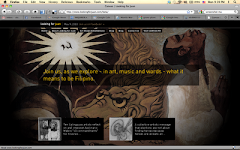Back in elementary school in the 70's, we used to be required to speak English all the time, and were fined a grand sum of ten centavos for each time we were caught slipping into the vernacular. The only exception was during Pilipino, which, ironically, was where most of us received our worst grades.
Does English make us more competitive, globally? I think that, undeniably, it does, especially for an increasingly infotech/call center driven economy like ours. I remember seeing an Indian website on the animation industry deadpanning that the advantage of the Filipinos is not only that we speak English (Indians also do), but that we understand the humor of Friends and The Simpsons.
Will an emphasis on English dilute our culture? Now there's a question!
Leading up to our main project in 2008, Manny Garibay and CANVAS are talking right now about a major art exhibition on the theme of What is a Filipino - Past, Present and Future. (The only details I can provide for now is that it's going to be held this October 2007 at the Ayala Museum). The idea, as with most of CANVAS' activities, is to encourage interaction between artists and writers, and one question we are still considering is whether we should require the writings to be in English in order to broaden the appeal to non-Filipinos. But will that be inconsistent with our theme?
Anyway, here's more food for thought from Peter Wallace, an American consultant who has lived here in the Philippines longer than many of us have been alive.
********************
ENGLISH SPOKE LIKE SHE IS
By Peter Wallace
Manila Standard (January 26, 2007)
Everyone knows about the serious decline in Filipinos’ ability to speak, read and write English, so it’s heartening to see efforts to teach it well being revived in schools. Something, though, that’s not going to be as easy as hoped is mainly because of the paucity of teachers.
So that’s the first thing that must be done: teach the teachers. Without that, no amount of executive orders or presidential mandates (good as they are) will succeed. As it now stands, only 19 percent of public school teachers passed a government-administered English proficiency test.
But there’s one area that’s been completely overlooked where probably more success could be gained than in anything else. That’s media.
Around 60 percent of Filipino households have access to television. In major urban areas, 20 percent watch TV at least seven hours daily, much of it soap operas and the like. Radio is ubiquitous, yet there is not one AM radio station in English and only one on TV. Broadcasters could help dramatically by introducing English into some of their programs. They should be encouraged to recognize that they could be a major participant in uplifting the lives of their listeners and viewers. Cartoons in English would be an excellent way to go. When you’re young, you can readily learn two languages. When you’re old, you can hardly cope with one. But that’s another story as Conrado de Quiros so sagely would say.
Related to this would be not to dub English movies, telenovelas and the like in Tagalog. Leave them in English, put Tagalog sub-titles so it becomes an English language session. Hearing English and translating it into Tagalog just like you’d do at school.
It’s the same in print although it doesn’t have the same mass audience as TV and radio. Most of the major national daily broadsheets are in English. But tabloids, which are written in Taglish (bastardized English), cost a lot cheaper than broadsheets and hence enjoy a higher circulation. They seem to be preferred by the C, D and E income brackets. A page or two in English wouldn’t hurt them, but would certainly help their readers to be more fluent in English.
Let’s get media into the picture. They’re not going to lose their audience by devoting, say, 10 percent of their time/space to English. It’s not asking much but it sure will achieve a lot.
A fast, dramatic improvement must be achieved. With all the best will in the world, this won’t and can’t be through the traditional schooling system. That’s just going to take time to put in place. And, anyway, it applies to kids. We need to employ adults now.
So there needs to be an alternative option. Media can be one. Advertisers can help, too. Have some of their ads and commercials in English and people will still get the message.
At the same time, this will improve people’s English comprehension skills.
Everyone’s talking “Corporate Social Responsibility” these days. Well, “teaching” English can be media’s contribution to society. And please don’t let me hear any bleating about losing the national language (which, incidentally, it’s not. Ask any Cebuano or Ilocano). I’m suggesting a dual system. And even the safety value of working overseas is denied them if they can’t speak English.
Call centers and backroom processing operations have grown by leaps and bounds—more than 100 percent per annum over the past five years. Some 145,000 Filipinos are now employed where none were a scant six years ago. But everyone acknowledges we’re running out of supply. Unless urgent change is effected, this industry of such promise will die—as have so many others before it.
Already, call centers are beginning to experience problems. Only 2 or 3 percent of Filipinos interviewed for call center jobs get the job. And this is down from 4 to 5 percent just a year or so ago. Call centers are locating in other cities in great part because of the increasing shortages in
The
We can’t afford to miss the Information Revolution. Already, the Philippines has achieved impressive success in the IT sector in call centers and, more recently, business process outsourcing (BPO) such as accounting, human resources, engineering drawing, animation, etc. But in all of this, English comprehension and not just speaking ability, is essential.
There seems to be a Philippine skill at missing opportunities, but this must not be one of them. But without large numbers of competently English-speaking people, it will be.
Every year, 1.25 million people enter the workforce. There aren’t that many jobs being created, and if those entrants can’t speak English, the number of job openings shrink dramatically. That shortage of jobs has forced Filipinos to flee. There are now 8.5 million Filipinos working overseas. Not one of them is there because they speak Tagalog. They are there because they can speak English.
Now here’s a thought. How many rich, successful Filipinos who can’t speak English are there? Not many. I’m not sure I know anyone in that category. The world speaks English (often as its second language). Even the huge Chinese population is learning it in its interaction with the world. Chinese is, of course, the other dominant language, at least in
There’s hundreds more words like that. Words from another language. English is a polyglot language. That’s one of the reasons it succeeded. If the
Peter Wallace can be reached at plw@mydestiny.net or by text at 0920.929.2929.








